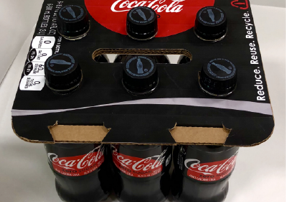The Pack Pack
The Pack Pack
| School: | Virginia Tech |
| Team: | Matt McBride, Christian Hamlett, Sam Marin, Robbie Pryor |

For our 48 hour repack design challenge we decided we wanted to tackle the issue of using unsustainable plastic rings in bottle and can packaging. With the limited time we had, we decided to specifically turn our focus onto the 16.9 fl. Oz. bottles that Coca-Cola uses. We wanted the design to be paper-based, capable of binding and supporting a 6-pack of bottles, adhesive-free, and able to further promote the Coca-Cola Brand. We achieved all of this, and hopefully economic and logistical viability, with our final design.
The core mechanism that made our design possible was a “finger-trap” inspired locking system that allowed us to fit bottles by their neck through a hole, but they could not be pulled back out without intentional force. This was achieved by layering two identical cap-sized holes, each facing opposite directions, so that in the case that the bottle was picked up by the board or pulled away, the two holes would pull in opposite directions, trapping the bottle. While this mechanism could be achieved by using paperboard, as is seen with other Coca-Cola products, we substituted the design with a single piece of B-fluted corrugated board to eliminate the need for a third layer, (and a third hole). From what we saw with minutes of testing the design, as long as the paperboard could withstand the force applied, the bottles were safely fastened.
We were able to replicate this feature that worked on one bottle to correctly function on an entire 6-pack without any adhesives or polymers. Ergonomics was the next goal, and to achieve a comfortable design for consumer handling, a window was added to the center of the design which could be grabbed with ease.
Overall we have achieved our goals in replacing the hi-cone rings with paper. Further considerations would include possible perforation to allow easier tear-away of the bottles. Slits around the holes for the bottles may also allow for easier ability to insert and remove the bottles without necessarily stripping any of the board strength away. Reduction of the board is possible but would have rendered us with little space for graphical elements but it is recommended that this action is taken to reduce paper consumption. Different paper calipers and folding combinations may be able to further this effort.
We were intrigued by the subject matter of the challenge and deeply appreciate the opportunity to compete.
